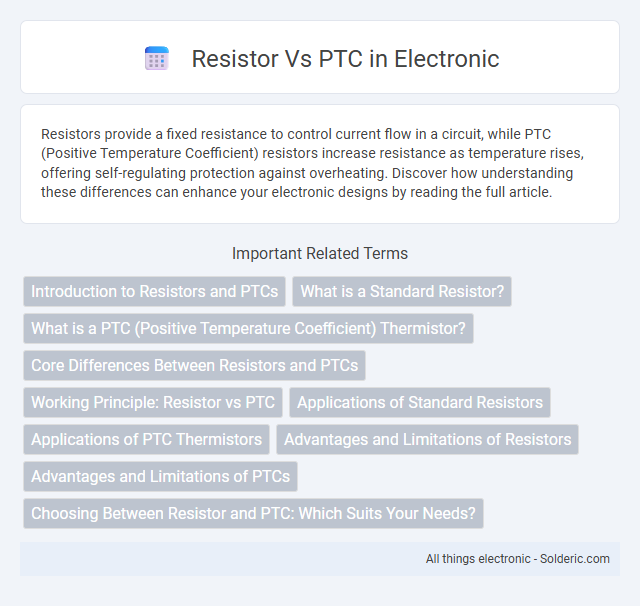Resistors provide a fixed resistance to control current flow in a circuit, while PTC (Positive Temperature Coefficient) resistors increase resistance as temperature rises, offering self-regulating protection against overheating. Discover how understanding these differences can enhance your electronic designs by reading the full article.
Comparison Table
| Feature | Resistor | PTC (Positive Temperature Coefficient Resistor) |
|---|---|---|
| Function | Limits electrical current by providing constant resistance | Increases resistance with temperature rise for overcurrent protection |
| Resistance Behavior | Constant resistance (Ohm's law) | Resistance rises sharply after threshold temperature |
| Material | Carbon, metal film, or wire wound | Polymer or ceramic materials with positive temp coefficient |
| Typical Use | Voltage dividers, current limiting, biasing circuits | Resettable fuses, circuit protection, current limiting |
| Response to Overcurrent | No self-resetting protection | Self-resetting after cooling down once fault clears |
| Temperature Range | Wide, depends on type | Limited to specified temperature threshold |
| Cost | Low | Moderate |
Introduction to Resistors and PTCs
Resistors regulate electrical current by providing a fixed resistance value, crucial in controlling voltage levels within circuits. Positive Temperature Coefficient (PTC) thermistors, on the other hand, increase their resistance as temperature rises, offering self-regulating protection against overheating and overcurrent conditions. Understanding the fundamental differences between standard resistors and PTC devices helps you select the right component for temperature-sensitive applications.
What is a Standard Resistor?
A standard resistor is an electronic component designed to provide a precise, fixed resistance value, regulating current flow within a circuit. Unlike a PTC (Positive Temperature Coefficient) resistor, which changes resistance with temperature to protect circuits from overheating, a standard resistor maintains a constant resistance regardless of temperature fluctuations. Your circuit relies on standard resistors to ensure stable voltage and current levels for reliable performance.
What is a PTC (Positive Temperature Coefficient) Thermistor?
A PTC (Positive Temperature Coefficient) thermistor is a type of resistor whose resistance increases significantly with temperature. Unlike standard resistors that maintain a constant resistance, a PTC thermistor responds dynamically, providing self-regulating protection in circuits by limiting excessive current flow as it heats up. Your electronic designs benefit from PTC thermistors by enhancing safety and reliability through temperature-dependent resistance control.
Core Differences Between Resistors and PTCs
Resistors provide a constant resistance value to limit current flow in electrical circuits, maintaining a fixed resistance under normal operating temperatures. PTC (Positive Temperature Coefficient) thermistors, however, increase their resistance significantly as temperature rises, enabling self-regulation and protection against overheating or overcurrent conditions. The core difference lies in the resistor's stability for current control versus the PTC's dynamic response to temperature changes for circuit protection.
Working Principle: Resistor vs PTC
A resistor works by providing a consistent resistance to electric current, converting electrical energy into heat, which remains stable regardless of temperature changes. A Positive Temperature Coefficient (PTC) thermistor increases its resistance significantly as the temperature rises, offering self-regulating protection against overcurrent by limiting current flow when overheating occurs. Your choice between these depends on whether you need fixed resistance or temperature-dependent current control.
Applications of Standard Resistors
Standard resistors are widely used in electronic circuits to control current flow, set voltage levels, and divide voltages in applications such as signal processing, power management, and sensor interfacing. Unlike PTC resistors that act as resettable fuses in overcurrent protection and temperature sensing, standard resistors provide precise resistance values essential for designing amplifiers, filtering signals, and biasing transistors. Their stability and accuracy make them indispensable components in consumer electronics, automotive systems, and industrial machinery.
Applications of PTC Thermistors
PTC thermistors are commonly used in overcurrent protection, motor starting, and temperature sensing due to their ability to increase resistance sharply with temperature rise. These devices safeguard circuits by limiting current during faults and stabilize motor performance in appliances like refrigerators and HVAC systems. Your electronic designs benefit from enhanced reliability and self-regulating temperature control when incorporating PTC thermistors.
Advantages and Limitations of Resistors
Resistors provide precise and stable resistance values essential for controlling current and voltage in electronic circuits, offering advantages like low cost, reliability, and simplicity in design. Their limitations include sensitivity to temperature changes, which can cause resistance drift, and the inability to self-adjust in response to varying current loads, unlike PTC thermistors that provide self-regulating protection. Understanding these characteristics helps you select the right component for applications needing fixed resistance versus dynamic current limitation.
Advantages and Limitations of PTCs
PTC thermistors offer the advantage of providing self-regulating overcurrent protection by increasing resistance sharply at a specific temperature, preventing damage to circuits without requiring external control. Their limitations include slower response times compared to fuses and potential reduced effectiveness in high-temperature environments where the device's trip point may be exceeded prematurely. Your choice of PTCs can enhance safety and reliability in electrical systems, especially where resettable protection is preferable over one-time fuses.
Choosing Between Resistor and PTC: Which Suits Your Needs?
Choosing between a resistor and a PTC (Positive Temperature Coefficient) thermistor depends on your circuit's protection and current limiting needs. Resistors provide a fixed resistance ideal for controlling current flow, while PTCs increase resistance with temperature, offering self-resetting overcurrent protection. Your decision should prioritize whether constant resistance or thermal-dependent safeguarding aligns better with your application's requirements.
resistor vs PTC Infographic

 solderic.com
solderic.com